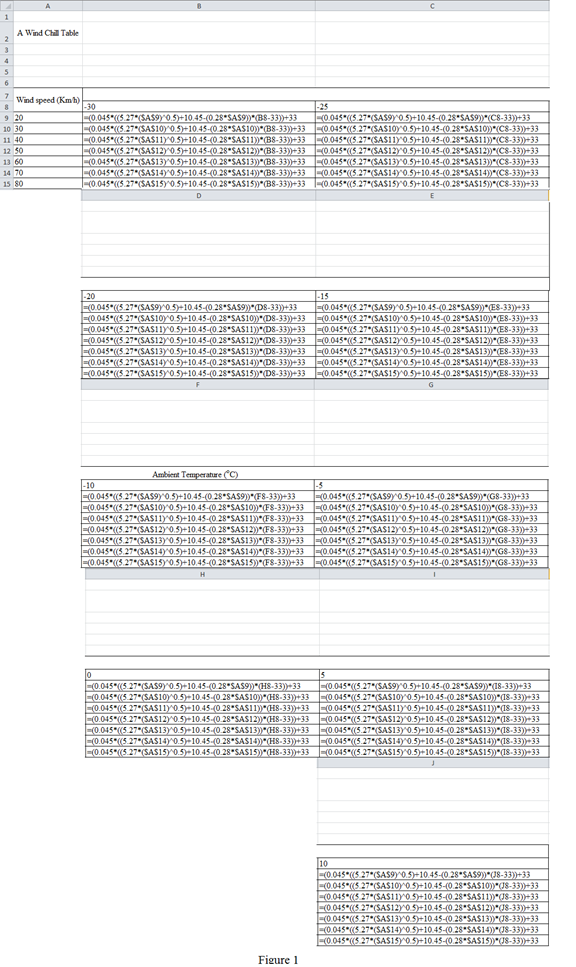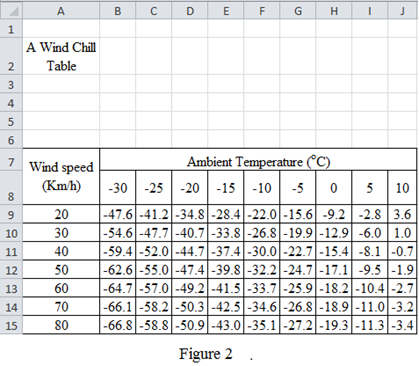
Concept explainers
Create a table that shows the windchill temperatures for the given range of ambient air temperature and wind speed.
Answer to Problem 19P
A table is created for the windchill temperatures with the given range of ambient air temperature and wind speed by using excel.
Explanation of Solution
Given data:
The range of ambient air temperature is
The range of wind speed is
Formula used:
Formula to calculate the more common equivalent windchill temperatures is,
Here,
Calculation:

Refer to the Figure 1:
Column A shows the wind speed (V) with range from
For the cell B9, the formula used to find the equivalent windchill temperatures as “
Written as “=(0.045*((5.27*($A$9)^0.5)+10.45-(0.28*$A$9))*(B8-33))+33”. Here, B8 cell represents the value of ambient air temperature is
For the cell B10, the formula used to find the equivalent windchill temperatures as “
Written as “=(0.045*((5.27*($A$10)^0.5)+10.45-(0.28*$A$10))*(B8-33))+33”. Here, B8 cell represents the value of ambient air temperature is
For the cell B11, the formula used to find the equivalent windchill temperatures as “
Written as “=(0.045*((5.27*($A$11)^0.5)+10.45-(0.28*$A$11))*(B8-33))+33”. Here, B8 cell represents the value of ambient air temperature is
For the cell B12, the formula used to find the equivalent windchill temperatures as “
Written as “=(0.045*((5.27*($A$12)^0.5)+10.45-(0.28*$A$12))*(B8-33))+33”. Here, B8 cell represents the value of ambient air temperature is
For the cell B13, the formula used to find the equivalent windchill temperatures as “
Written as “=(0.045*((5.27*($A$13)^0.5)+10.45-(0.28*$A$13))*(B8-33))+33”. Here, B8 cell represents the value of ambient air temperature is
For the cell B14, the formula used to find the equivalent windchill temperatures as “
Written as “=(0.045*((5.27*($A$14)^0.5)+10.45-(0.28*$A$14))*(B8-33))+33”. Here, B8 cell represents the value of ambient air temperature is
For the cell B15, the formula used to find the equivalent windchill temperatures as “
Written as “=(0.045*((5.27*($A$15)^0.5)+10.45-(0.28*$A$15))*(B8-33))+33”. Here, B8 cell represents the value of ambient air temperature is
Table 1 is created to shows a Wind Chill Temperature.
Table 1
| Wind speed (Km/h) | Ambient Temperature | ||||||||
| -30 | -25 | -20 | -15 | -10 | -5 | 0 | 5 | 10 | |
| 20 | -47.6 | -41.2 | -34.8 | -28.4 | -22.0 | -15.6 | -9.2 | -2.8 | 3.6 |
| 30 | -54.6 | -47.7 | -40.7 | -33.8 | -26.8 | -19.9 | -12.9 | -6.0 | 1.0 |
| 40 | -59.4 | -52.0 | -44.7 | -37.4 | -30.0 | -22.7 | -15.4 | -8.1 | -0.7 |
| 50 | -62.6 | -55.0 | -47.4 | -39.8 | -32.2 | -24.7 | -17.1 | -9.5 | -1.9 |
| 60 | -64.7 | -57.0 | -49.2 | -41.5 | -33.7 | -25.9 | -18.2 | -10.4 | -2.7 |
| 70 | -66.1 | -58.2 | -50.3 | -42.5 | -34.6 | -26.8 | -18.9 | -11.0 | -3.2 |
| 80 | -66.8 | -58.8 | -50.9 | -43.0 | -35.1 | -27.2 | -19.3 | -11.3 | -3.4 |
Figure 2 shows a wind chill table in the excel sheet has obtained as similar to given Problem 14.19 in the textbook

Conclusion:
Hence, a table is created for the windchill temperatures with the given range of an ambient air temperature, and wind speed have been explained using excel.
Want to see more full solutions like this?
Chapter 14 Solutions
EP WEBASSIGN FOR MOAVENI'S ENGINEERING
- The 4-story building shown below has a dead load D = 90 psf, floor live load, L = 110 psf. The roof and floors have the same D and L loads. The length of columns is 24 ft at the ground level and 12 ft for all other floors. The column ends are pins (Kx = Ky = 1.0) and Lx = Ly for all columns. (Use LFRD Method where applicable).1) Determine Pu on interior columns B2-4, B2-1, and side column C1-1 2) Use Table 4-1a (p. 4-12 to 4-24) in AISC to select the lightest W shapes for these columns 3) Use Table 4-4 (p. 4-68 to 4-83) in AISC to select lightest square HSS shape for the columnsarrow_forwardThe 4-story building shown below has a dead load D = 90 psf, floor live load, L = 110 psf. The roof and floors have the same D and L loads. The length of columns is 24 ft at the ground level and 12 ft for all other floors. The column ends are pins (Kx = Ky = 1.0) and Lx = Ly for all columns. Determine Pu on interior columns B2-4, B2-1, and side column C1-1 (Use LFRD where applicable).arrow_forwardProblems 5-1 Stead flow of steam enters a condenser with an enthalpy of 2400 kJ/kg and a velocity of 366 m/sec. the condensate leaves the condenser with an enthalpy of 162kJ/sec and a velocity of 6 m/sec what is the heat transferred to the cooling water per kg steam condensed. (-69198 kJ/kg) 5-2 An air compressor delivers 4.5 kg of air per minute at a pressure of 7 bar and a specific volume of 0.17 m³ /kg. Ambient conditions are pressure 1bar and specific volume 0.86 m³/kg. The initial and final internal energy values for the air are 28 kJ/kg and 110 kJ/kg respectively. Heat rejected to the cooling jacket is 76kJ/kg of air pumped. Neglecting changes in kinetic and potential energies, what is the shaft power required driving the compressor? (14.3kW)arrow_forward
- Determine the design resistance to transverse force F,Rdarrow_forwardAs a structural engineer, your task is to design an optimum section that has sufficient resistance to the applied loading for the primary beam proposed in Figure 1. A UB in grade S275 steel is required for the unrestraint beam to carry the ultimate loads over the given span. Choose an optimumUB section and justify your selection. You are required to submit a design analysis by considering bending, shear, transverse force, and deflection checking for the selected member based on Eurocode 3 and the assumption of support condition and loading must be clearly stated. P=15 kN. a 2 m. b=3m ·L· ·b. Figure 1 Simply supported steel beamarrow_forwardWhy is it important to establish logical relationships between tasks when developing a construction schedule?arrow_forward
- For the gravity concrete dam shown in the figure, the following data are available: - Unit weight of concrete (Yeone) = 2.4 ton/m³ Neglect( Wave pressure, silt pressure, ice force and earth quake force) -0.65, (Ywater) 1 ton/m³ Find factor of safety against sliding and overturning (F.Said & F.Sover), If heel and toe stresses (Pais & Pmas) are 57.17ton/m2 and 84.53 ton/m² respectively. w.s.l 83m 10m 80m 8m Solve on paper step by step with sketcharrow_forwardWhy is proper planning important when developing a baseline construction project schedule?arrow_forwardDetermine the minimum possible surface area of a secondary clarifier treating activated sludge with a design influent flow rate (Q) of 1,000 m³/d, a return activated sludge (RAS) recycling ratio of 25%, and a mixed liquor total suspended solids (MLSS) concentration of 4,000 mg/L, if the overflow rate must be less than 33 m/d and the solids loading rate must be less than 250 kg/m²/d. Express your answer in m² and round up to the next integer.arrow_forward
- Estimate the required air flow rate for the new activated sludge plant at Pea Ridge (Problems 23-223-723-10, and 23-13). The flow rate is 8,450 m³/day, the concentration of bCOD going into the system (So) is 137 mg/L, the concentration of bCOD leaving the system (S) is 16.3 mg/L, and the mass of cells produced per day (Pxvss) is 277.4 kg/d. Use the following assumptions to estimate the required air flow rate: . Clean water correction, a = 0.50 . Salinity correction, B = 0.95 Fouling factor = 0.9 Wastewater temperature = 12°C Atmospheric pressure = 101.325 kPa .Elevation 500 m . Depth of aerator = 5.6 m Operating DO 2.0 mg/L Percent oxygen leaving aeration tank - 19% ■ Manufacturer's SOTR = 535 kg/d Manufacturer's air flow rate at standard conditions 50 m³/d - aerator Express your answer with the units of m³/d and round to the nearest integer.arrow_forwardDetermine the required solids retention time (SRT) of a completely mixed activated sludge aeration tank for a conventional activated sludge system treating a design flow rate of 34,560 m³/d, where the effluent standards are 30.0 mg/L for BODs and 30.0 mg/L for total suspended solids (TSS). Assume that the BOD5 of the effluent TSS is 70% of the TSS concentration. Assume the BODs concentration leaving the primary clarifier is 128 mg/L that the MLVSS concentration (X₂) is 2,500 mg/L. Assume the following values for the growth constants: Ks 100 mg/L BODS ⚫ Hm - 2.5 d 1 kd = 0.050 d 1 Y = 0.50 mg VSS/mg BODs removed Express your answer in days and round to the nearest 0.1.arrow_forwardQ1: Figure below shows loaded beam with its cross-section area, (A) Draw shear force and bending moment diagrams, stating the main values, (B) Find central slope and deflection, (C) Sketch the distribution of shear stress at left support, (D) Find maximum tensile and compressive bending stresses set up in beam at right support. E-205GN/m² P1 P2 P3 W1 W2 Lin Lin # A Length in (m) and loads in kN 3a a 2a 2a (Cross-section area, All dimensions in (mm))arrow_forward
 Engineering Fundamentals: An Introduction to Engi...Civil EngineeringISBN:9781305084766Author:Saeed MoaveniPublisher:Cengage Learning
Engineering Fundamentals: An Introduction to Engi...Civil EngineeringISBN:9781305084766Author:Saeed MoaveniPublisher:Cengage Learning
